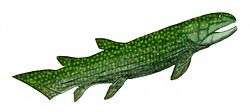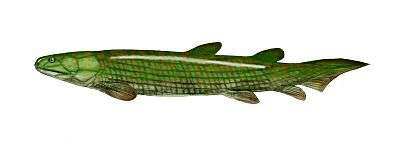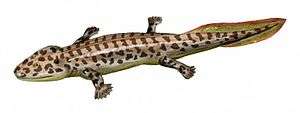Rhizodus
| Rhizodus | |
|---|---|
| Fossil tooth of Rhizodus hibberti | |
| Scientific classification | |
| Kingdom: | Animalia |
| Phylum: | Chordata |
| Class: | Sarcopterygii |
| Clade: | Tetrapodomorpha |
| Order: | †Rhizodontida |
| Family: | †Rhizodontidae |
| Genus: | †Rhizodus Owen, 1840 |
| Species: | †R. hibberti |
| Binomial name | |
| Rhizodus hibberti Owen, 1840 | |
Rhizodus (root tooth) is an extinct genus of rhizodont, a branch of the Sarcopterygii, the bony vertebrate clade that also includes tetrapods.
Description

The most notable characteristics of Rhizodus, compared to other giant lobe-fins such as Barameda, were the two 22 centimetres (8.7 in) fangs located near the front of its jaws,[1] followed by other teeth scaling downwards in size. Rhizodus was a giant apex predator that resided in freshwater lakes, river systems and large swamps in the entire Carboniferous period, feeding on small to medium-sized amphibians, using its teeth to kill prey and rip it into digestible sizes, rather than swallowing prey whole like other, smaller-toothed sarcopterygians.[2]
Fossil skin imprints show that Rhizodus had large, plate-like scales, similar to those found on modern day arapaima.[3]
Diet
Rhizodus' diet includes medium sized fish and temnospondyls. It has been proposed that Rhizodus may have lunged at terrestrial, shorebound prey, just like a modern day crocodile.[4]
References
- ↑ https://www.europeana.eu/portal/record/2022312/93D4B7C2318323299A00BD2DBFBDC3D53C65CF02.html
- ↑ http://www.twmuseums.org.uk/geofinder/search/item.php?record=NEWHM:2004.H206
- ↑ http://www.ucl.ac.uk/museums-static/obl4he/vertebratepalaeo/34_rhizodus.html
- ↑ http://www.ucl.ac.uk/museums-static/obl4he/vertebratepalaeo/34_rhizodus.html





